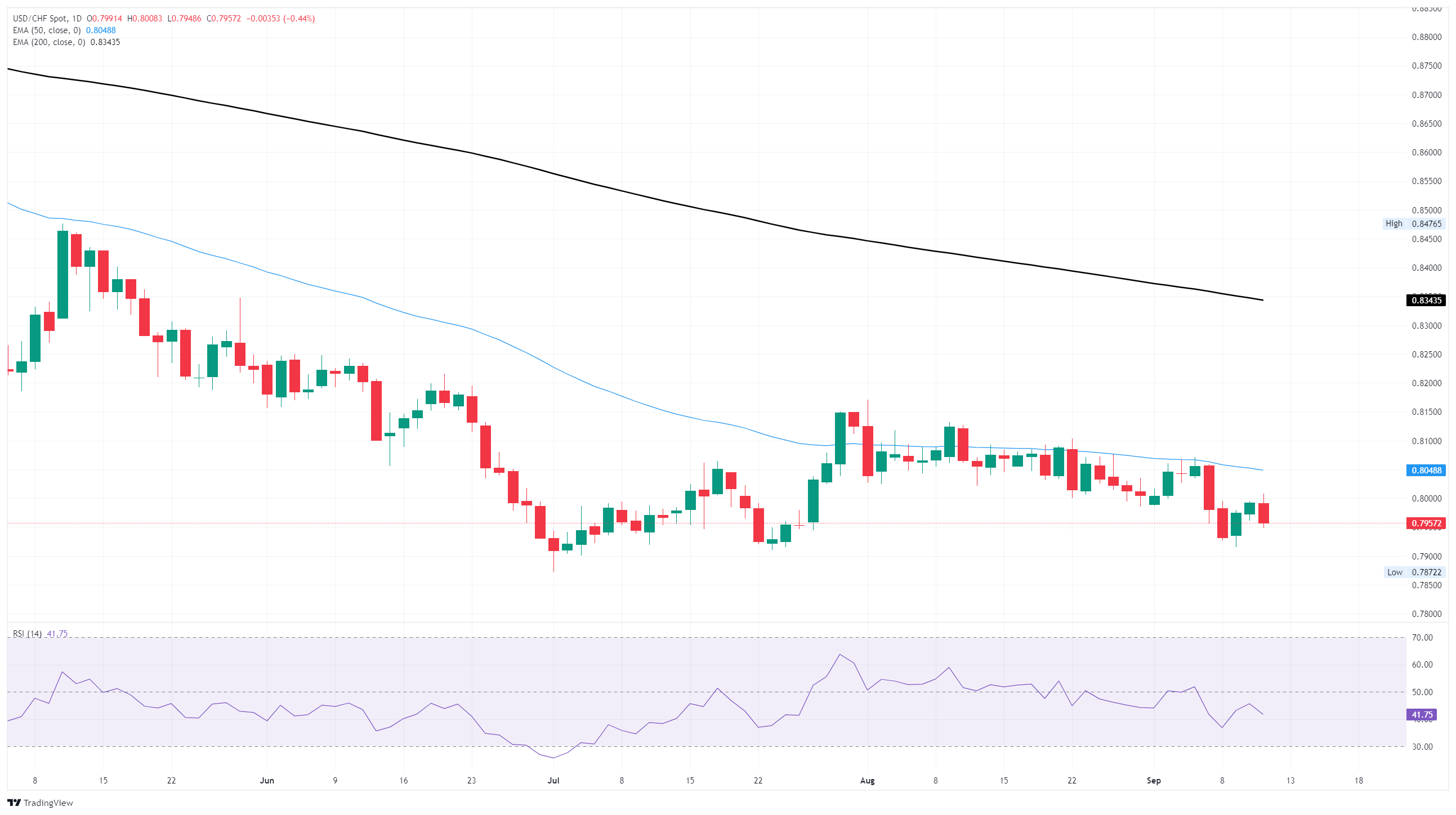USD/CHF eases as Greenback declines amid Fed rate cut expectations
- USD/CHF pared away near-term gains, testing back into recent lows.
- The Fed is still on pace to deliver an interest rate cut next week despite another uptick in CPI inflation.
- The SNB is battling rate cut expectations of its own, with markets weighing odds of negative rates.
USD/CHF chalked in a technical rejection of the 0.8000 handle on Thursday, with the US Dollar (USD) taking a beating across the board. The Federal Reserve (Fed) is functionally locked into an interest rate cut at its upcoming interest rate decision on September 17, while the Swiss National Bank (SNB) is battling rate cut expectations of its own, with markets gearing up for the SNB to pivot back into negative rate territory. The SNB exited its negative rate policy stance just three years ago, and the Swiss central bank is now battling market forces that are pushing rates back below zero.
US CPI rises, but Fed rate cuts still on track
Headline US CPI inflation rose again in August, with the annualized index rising to 2.9% and the monthly number accelerating to 0.4% as front-end inflationary pressure continues to build. Shelter and food prices were the largest drivers of near-term inflationary pressure, with the grocery items index rising 0.5% over a single month. Core CPI inflation, or headline inflation less energy and food prices, rose to 2.9% YoY, landing within median market forecasts.
Despite another rise in key inflation pressure, August’s CPI inflation data wasn’t enough to derail market expectations for a Fed interest rate cut next week. According to the CME’s FedWatch Tool, interest rate futures traders are fully pricing in three rate cuts before the end of the year. A 25-basis-point cut is a foregone conclusion at the Federal Open Market Committee’s (FOMC) interest rate decision on September 17, and rate markets are pricing in nearly 95% odds that the Fed will deliver follow-up rate trims on October 29 and December 10.
USD/CHF daily chart

Swiss Franc FAQs
The Swiss Franc (CHF) is Switzerland’s official currency. It is among the top ten most traded currencies globally, reaching volumes that well exceed the size of the Swiss economy. Its value is determined by the broad market sentiment, the country’s economic health or action taken by the Swiss National Bank (SNB), among other factors. Between 2011 and 2015, the Swiss Franc was pegged to the Euro (EUR). The peg was abruptly removed, resulting in a more than 20% increase in the Franc’s value, causing a turmoil in markets. Even though the peg isn’t in force anymore, CHF fortunes tend to be highly correlated with the Euro ones due to the high dependency of the Swiss economy on the neighboring Eurozone.
The Swiss Franc (CHF) is considered a safe-haven asset, or a currency that investors tend to buy in times of market stress. This is due to the perceived status of Switzerland in the world: a stable economy, a strong export sector, big central bank reserves or a longstanding political stance towards neutrality in global conflicts make the country’s currency a good choice for investors fleeing from risks. Turbulent times are likely to strengthen CHF value against other currencies that are seen as more risky to invest in.
The Swiss National Bank (SNB) meets four times a year – once every quarter, less than other major central banks – to decide on monetary policy. The bank aims for an annual inflation rate of less than 2%. When inflation is above target or forecasted to be above target in the foreseeable future, the bank will attempt to tame price growth by raising its policy rate. Higher interest rates are generally positive for the Swiss Franc (CHF) as they lead to higher yields, making the country a more attractive place for investors. On the contrary, lower interest rates tend to weaken CHF.
Macroeconomic data releases in Switzerland are key to assessing the state of the economy and can impact the Swiss Franc’s (CHF) valuation. The Swiss economy is broadly stable, but any sudden change in economic growth, inflation, current account or the central bank’s currency reserves have the potential to trigger moves in CHF. Generally, high economic growth, low unemployment and high confidence are good for CHF. Conversely, if economic data points to weakening momentum, CHF is likely to depreciate.
As a small and open economy, Switzerland is heavily dependent on the health of the neighboring Eurozone economies. The broader European Union is Switzerland’s main economic partner and a key political ally, so macroeconomic and monetary policy stability in the Eurozone is essential for Switzerland and, thus, for the Swiss Franc (CHF). With such dependency, some models suggest that the correlation between the fortunes of the Euro (EUR) and the CHF is more than 90%, or close to perfect.

